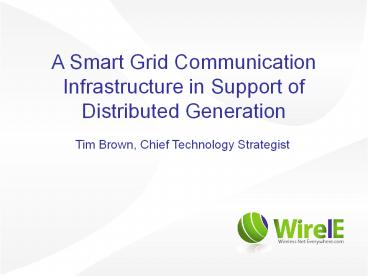A Smart Grid Communication - PowerPoint PPT Presentation
1 / 16
Title:
A Smart Grid Communication
Description:
WireIE and the University of Ontario Institute of Technology (UOIT) are ... Distributed Generation by its very nature is a game changer for utilities. ... – PowerPoint PPT presentation
Number of Views:205
Avg rating:3.0/5.0
Title: A Smart Grid Communication
1
A Smart Grid Communication Infrastructure in
Support of Distributed Generation
Tim Brown, Chief Technology Strategist
2
Agenda
- Potential Smart Grid applications
- Urban Rural Distributed Generation scenarios
- Smart Grid communications in addressing
Distributed Generation - Potential issues
- Concluding remarks
3
Contributors to the Presentation
WireIE and the University of Ontario Institute of
Technology (UOIT) are collaborating on a vision
for Smart Grid.
4
Potential Smart Grid Applications
- WASA Wide Area Situational Awareness.
- Control systems for self-healing.
- SCADA maintain reliability under failure
scenarios. - Performance analysis troubleshooting/Trend
Analysis. - Automated control of breakers, capacitor banks,
voltage regulators, etc. - Flexible AC Transmission Systems (FACTS) Devices.
5
Distributed Generation Enabled by Smart Grid
- Distributed Generation by its very nature is a
game changer for utilities. - Countless dispersed points of generation.
- Direction of current flow is dynamic in contrast
to todays predictable, static environment. - Serious protection control considerations.
- Distributed Generation is an opportunity to take
advantage of Smart Grids most advanced
communication capabilities.
6
Distributed Generation Scenario 1
- Rural Radial Distribution Islanding
7
Distributed Generation Scenario 2
- Urban Meshed Distribution System
8
Smart Grid Communications in Addressing DG
Scenarios
- Low latency 6 cycles or 100 ms.
- Fibre optic cable is 5 microseconds per 1
kilometer strand. - Radio technologies cannot meet the 100 ms
constraint the only exception being WiMAX. - A WiMAX link (base station to CPE) is 10 ms or
less. - Core network and radio access must therefore be
designed for an aggregate latency of less than
100 ms.
9
Smart Grid Communications in Addressing DG
Scenarios
- WiMAX has many other advantages over and above
low latency. - Throughput. Actual value is dependant on network
configuration settings. 5 Mbps per link is
realistic in Smart Grid. - Adaptive Modulation. Throughput is traded off for
signal robustness, should radio link quality
change. - Closed loop Power Control. Mitigates
self-interference on the network and minimize
electrical power consumption.
10
Smart Grid Communications in Addressing DG
Scenarios
- Quality of Service (QOS). Allows the operator to
prioritize mission-critical protection control
functions over less time-sensitive functions. - Even with these powerful and effective signal
quality mechanisms, a comprehensive Radio
Frequency path analysis and subsequent network
design is essential. - LTE (Long Term Evolution) is another 4G wireless
telecommunications technology currently under
development. Similar characteristics to WiMAX,
including comparable latency.
11
Internet Protocol (IP) Advantages Through
Standardization
- IP is the foundation of the Internet and World
Wide Web applications. - Business, industry, government, education,
healthcare and society at large have been
revolutionized by the Internet. - Open, secure, flexible, redundant, diverse,
relative simplicity. - Deployment and operational costs are relatively
low as many key network components are commodity
items. - Both WiMAX and LTE are based on IP.
12
Payload Latency
- By pure definition, latency is a function of
communication media. - Protocol overhead can, however, contribute to
payload latency. - TCP (Transmission Control Protocol) has the most
overhead but benefits from packet delivery
assurance essential in protection control
applications.
13
Payload Latency
- UDP (User Datagram Protocol) much lower
overhead and suitable for non-mission critical
applications such as - Situational awareness
- Performance analysis troubleshooting
- Trend Analysis delivery of grid asset health data
- Distributed Generation would use TCP in light of
its packet delivery assurance benefits. - Distributed Generation would also be given
highest priority QOS.
14
Potential Issues
- Complexity.
- New operational practices cultural shift
towards IT in the electrical utility sector. - Regulatory issues.
15
Concluding Remarks
- WireIE UOIT invite you to participate as we
develop a simulation of the rural islanding, and
urban meshed distribution system scenarios. - Targeted for completion by the end of 2009.
- Simulation includes communication infrastructure
overlay. - Based on the outcome, a functioning demonstration
will be built in conjunction with an LDC.
16
- Thank You































